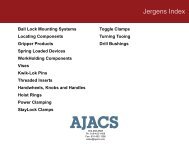Vibro/Dynamics Catalog - Ajacs Die Sales Corporation
Vibro/Dynamics Catalog - Ajacs Die Sales Corporation
Vibro/Dynamics Catalog - Ajacs Die Sales Corporation
Create successful ePaper yourself
Turn your PDF publications into a flip-book with our unique Google optimized e-Paper software.
From this simple model, the equation describing the vertical motion of the<br />
anvil mass, m 2 can be solved as Equation 6.<br />
Reviewing the variables within Equation 6;<br />
• The motion of the hammer system is reduced when the anvil<br />
weight, m 2 , is increased and,<br />
• The motion is increased with a softer, lower natural frequency<br />
system, Ω . d<br />
If a generally accepted limit of 7mm peak motion is applied, then it is clear<br />
that for coil spring and elastomeric systems there may be a need for the<br />
anvil to weigh more in order to maintain the natural frequency and isolation<br />
performance, as shown in Figure 4. Because of the cost to add a concrete or<br />
steel inertia mass, the MRM and VPS elastomer systems are more economical at the expense of a very small reduction in isolation effectiveness. A steel<br />
inertia mass is more economic since a steel plate is more dense and requires less space, thereby reducing the area and size of the foundation, see<br />
Figure 5. Field installations have proven the steel inertia masses to be more durable.<br />
By Hooke’s Law, the force transmitted to the foundation is the product of the<br />
isolation system dynamic stiffness, K, and the anvil motion x(t):<br />
For coil spring isolators, the addition of a<br />
viscous damper mechanism adds a small<br />
amount of force to the force transmitted by the<br />
support springs. For elastomeric designs, the<br />
hysteresis damping of the material is included<br />
in the real dynamic stiffness.<br />
The forces generated in the die space are<br />
enormous. The exact magnitude and time<br />
duration are generally not known because<br />
measuring the force is not possible. However,<br />
experienced hammer operators can easily<br />
notice a significant reduction in body and arm<br />
fatigue of an isolated hammer compared to a<br />
traditionally supported hammer on timbers or<br />
thin pad material. The correct application of<br />
a well designed isolation system will result in<br />
a significant reduction of the ram’s enormous<br />
impact shock. The MRM and VPS Systems<br />
transform the impact shock from a series of<br />
short duration, high magnitude impulses, as shown in Figure 2, to a series of<br />
longer duration, smaller magnitude impulses, as shown in Figure 6. Isolation<br />
of these impact shocks will decrease health problems, decrease building<br />
maintenance, decrease neighbor complaints, and decrease foundation costs.<br />
Summary<br />
The MRM and VPS Elastomeric Isolation Systems have proven to be a very<br />
effective for forging hammers. When compared to traditional forge hammer<br />
installation methods, like timbers and rubber pads, the isolation performance<br />
of MRM and VPS Systems are clearly superior, yet they’re faster and easier to<br />
install due to their unitized construction. MRM system isolation performance<br />
approaches that of coil spring systems, while VPS systems are slightly stiffer.<br />
Both are economical and extremely durable. See <strong>Vibro</strong>/<strong>Dynamics</strong> Technical<br />
Bulletin M/L 710 for vibration isolation comparisons.<br />
Since <strong>Vibro</strong>/<strong>Dynamics</strong> <strong>Corporation</strong> has the technology and know how<br />
to design and build both MRM and VPS Elastomer and FS Spring Mount<br />
Isolation Systems, we are in the best position to recommend an isolation<br />
system that best fits your needs.




